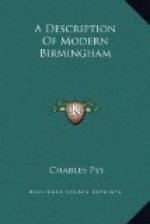Here are two churches; one dedicated to St. Mary and the other to St. Nicholas: there, are also places of worship for presbyterians, quakers, independants, baptists, and Wesleyans.
In the vicinity, the following places are deserving of attention:—Guy’s cliff, the ruins of Kenilworth castle, Stoneleigh abbey, Charlcott-house, and Combe abbey. Passing over the new bridge, on the road to Leamington, there is a grand picturesque view of Warwick; there being in the foreground the rich meadows, with the Avon meandering through them, the church of St. Nicholas, and the trees behind, which form a dark shade. Near to it is the castellated entrance into the castle, and the elegant tower of St. Peter’s chapel. On the right is the priory, with its beautiful woods. The town is perceptible in the centre, with the tower of St. Mary’s, which rises above the variegated and extensive groves of the castle. On the left is the principal object, the castle, which raises its lofty embattled towers over the shady groves with which it is surrounded. The elegant bridge, whose span is 105 feet, is a prominent feature in the landscape.
On the road leading to Tachbrook, about one mile from the town, the eye is gratified with a rich and luxuriant landscape, wherein appears the church of St. Nicholas, the priory, the hospital of St. John, the tower of St. Mary’s church, and, to crown the whole, the castle.
The walks and rides in the vicinity of this town present innumerable objects deserving of attention, and whoever takes delight in rural scenery, may here be amply gratified.
In addition to these works, there is a considerable manufactory of hats, and an iron-foundry; to which may be added a corn mill, wherein are five pair of stones, and three of them constantly in motion, by which means they are enabled to grind and dress three hundred bushels of flour every day.
The County Hall.
This is an elegant pile of building, with a stone front, ornamented with pillars of the Corinthian order, to which, the ascent is by a flight of steps, through folding doors, into a noble room of just proportions, being ninety-four feet in length and thirty-six in breadth. At each end are semicircular recesses, surmounted by cupolas, and fitted up with convenient galleries, where the two courts of justice are held; the criminal court being on the right, and that for civil causes on the left; between which there is accommodation for the servants and attendants upon the court. Above there is an apartment where the petit juries




